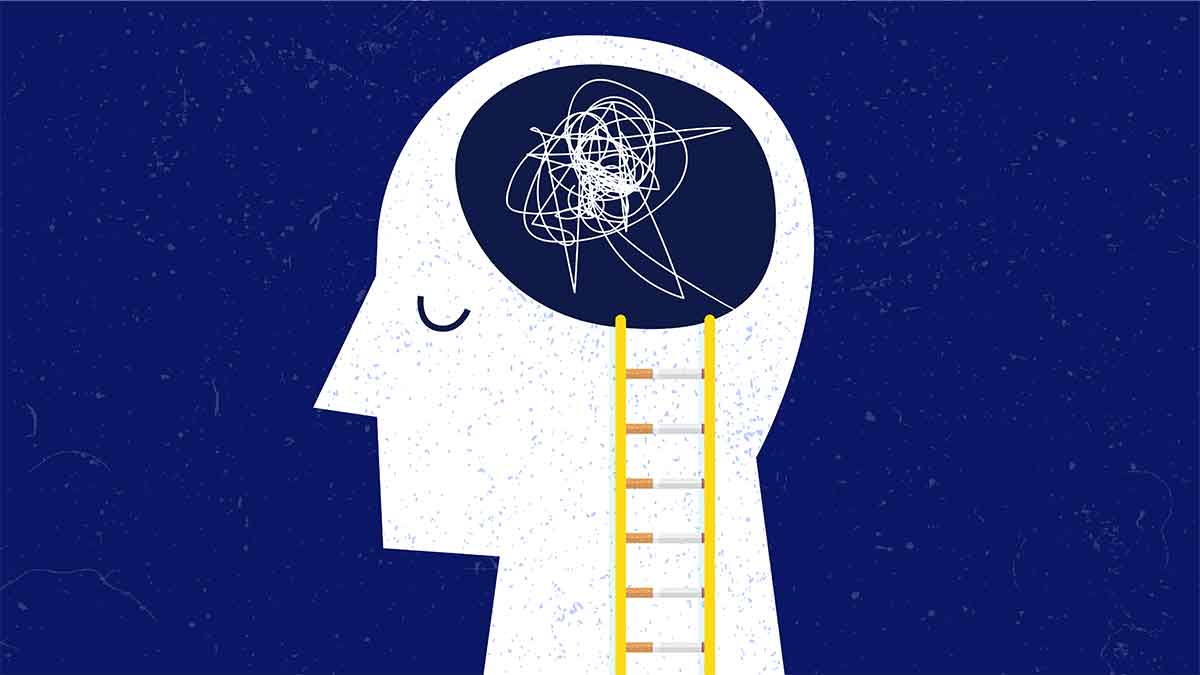- Resources
- News
-
-
Get Email Updates
Sign up for STOP's emails and never miss an update on our latest work and the tobacco industry's activity.
-
Get Funding
Ready to tackle industry interference? You could be eligible for a grant.
-
Share a Tip
Do you have information on tobacco industry misconduct in your country? Let us know.
-
Get Email Updates

It’s the pandemic. It’s economic instability. It’s political unrest. It’s the climate crisis.
Any of these could be cited as contributors to the world’s mental health crisis—the one where, even before the pandemic, an estimated one in eight people were living with a mental health disorder, according to the World Health Organization (WHO). COVID hasn’t helped. WHO estimates that both anxiety and depressive disorders rose by more than 25% during the first year of the pandemic, with young people being especially susceptible.
The past two-plus years have also taken a toll on the mental health of those who do not live with a diagnosed mental illness, but are feeling increased stress and anxiety due to current circumstances.
But there’s another contributor to this crisis that doesn’t often get the scrutiny it deserves for capitalizing on and exacerbating declines in mental health: the tobacco industry. Here’s what it does.

Contrary to the tobacco industry’s depictions, data shows that tobacco use can increase levels of depression, anxiety, stress and psychiatric symptoms.
Normalizing tobacco and nicotine as stress relievers
There’s a reason many people associate smoking with stress relief and relaxation: targeted tobacco advertising. It started almost 100 years ago with ads like this one asking consumers, “Do you smoke away anxiety?” This Camel ad, targeted at women with “jangled nerves,” asserts that, in addition to getting a full night’s sleep, eating well and staying active, smoking Camels is an effective way to manage stress. Another ad, from 2000, depicts a peaceful nature setting where a man smokes as he floats on an inner-tube on a calm body of water. To complement the serene setting, the word “Relax” is featured prominently.
Contrary to the tobacco industry’s depictions, data shows that tobacco use can increase levels of depression, anxiety, stress and psychiatric symptoms. Nevertheless, the industry’s attempts to cast its products as coping mechanisms may have worked. One U.K. study showed that of smokers who indicated worrying about their mental health during the pandemic, 42% reported smoking more than they did before the pandemic, while only 21% said they smoked less.
Trying to push these addictive, harmful products on people experiencing increased anxiety only exacerbates the problem. A Cochrane review concluded that smokers who quit not only saw a decline in symptoms of anxiety and depression, they saw an increase in positive feelings and mental well-being.
This industry-manufactured association between tobacco or nicotine use and managing anxiety has extended to e-cigarettes. While some e-cigarettes do not contain tobacco, they do contain addictive nicotine. This 2014 online ad for blu, an e-cigarette owned by Imperial Brands, promises that when you use the product, you’ll “never feel more relaxed.”
Promoting “stress relief” to hook new, young users
Especially concerning is the industry’s marketing to young people. In particular, the industry has heavily promoted electronic products, like e-cigarettes and heated tobacco products, to young people—including via ads that portray these products as stress reducers.
Young people were not spared the additional stress, anxiety and depression caused by the pandemic. A WHO scientific brief on mental health and COVID reported that young people, particularly those ages 20-24, were more affected by major depressive disorders and anxiety disorders than older people. This dip in mental well-being dangerously coincided with targeted ads, such as those highlighted by the Truth Initiative. These ads portray e-cigarettes as stress relievers, including one that prompted consumers to “stay sane” with its product between Zoom calls and texts from parents during COVID lockdowns.
Nicotine has been shown to have negative effects on young people’s mental health: One study showed that adolescent consumption of nicotine was associated with depressive symptoms. Other data indicates that youth e-cigarette use can perpetuate a cycle of anxiety, with young people taking up e-cigarettes to find relief from anxiety, stress or depression, and then feeling those symptoms again when going through temporary withdrawal from nicotine. This prompts continued use of e-cigarettes to manage their mental health.
Causing harm to those diagnosed with severe mental illness
The Truth Initiative highlights that the tobacco industry has given free or low-cost cigarettes to psychiatric hospitals, targeting these facilities with “value” brands in the 1980s and ‘90s. At first glance, this may seem charitable. It’s a commonly held belief that those living with severe mental illness need cigarettes to help them cope, but this notion may be attributed to the tobacco industry. The industry has funded research that promoted the belief that smoking was a type of self-medication for those living with schizophrenia and that those living with schizophrenia were “less susceptible to the harms of tobacco.”

The industry’s very operations create conditions that are not conducive to good mental health.
In reality, these donations were more likely a business move for the industry’s financial benefit. It’s well-documented that people with serious mental illness are more likely to use tobacco than those without, so the industry likely sees this group as a reliable market. Further, people living in psychiatric facilities may not have the support they need to quit if they want to, as cessation programs in psychiatric facilities are often “rare or delayed,” (for example, when clinicians don’t prioritize tobacco use as a problem). The industry has also tried to suppress promotion of smoke-free policies in mental health facilities, allowing for the continued use of its products.
Targeting those living with diagnosed mental illnesses makes them more vulnerable to physical harm. People who live with mental illness tend to have a shorter life expectancy than those who do not, but this isn’t necessarily due to mental illness. ASH U.K. has summarized research that concludes smoking is actually a leading driver of this life expectancy gap.
Creating conditions that hurt global mental health
The tobacco industry’s contributions to the growing mental health crisis go beyond any intentional marketing and targeting of specific groups. Its very operations create conditions that are not conducive to good mental health.
Tobacco farming practices have been flagged for the perpetuation of poverty among growers and the use of child labor. Growing and manufacturing tobacco and nicotine products leads to numerous environmental harms and contributes to the global climate crisis. And tobacco use is proven to cause numerous diseases, including those that can drastically reduce one’s quality of life. Each of these scenarios is a hindrance to promoting and preserving good mental health.
We can improve global mental health by holding the industry accountable
One thing is certain: Improving mental health around the world must become a global priority. An important part of that is calling out the tobacco industry’s efforts to capitalize on the mental health crisis and demand that it be held accountable for its operations that can harm mental health. Young people around the world have already begun. In August 2022, the International Youth Tobacco Control group published a statement condemning the industry’s targeting of young people and demanding that governments hold the industry accountable for the harms it causes.
It is possible to prevent the industry from preying on those with mental health struggles, especially young people. For example, tobacco advertising, promotion and sponsorships should be banned—and already are in several countries, in accordance with the WHO Framework Convention on Tobacco Control, a global treaty to reduce tobacco use. Reducing tobacco use and the demand for tobacco industry products would improve physical health, help break cycles of poverty, alleviate poor working conditions in the industry and reduce environmental harm—all things that lay the groundwork for better mental health.



